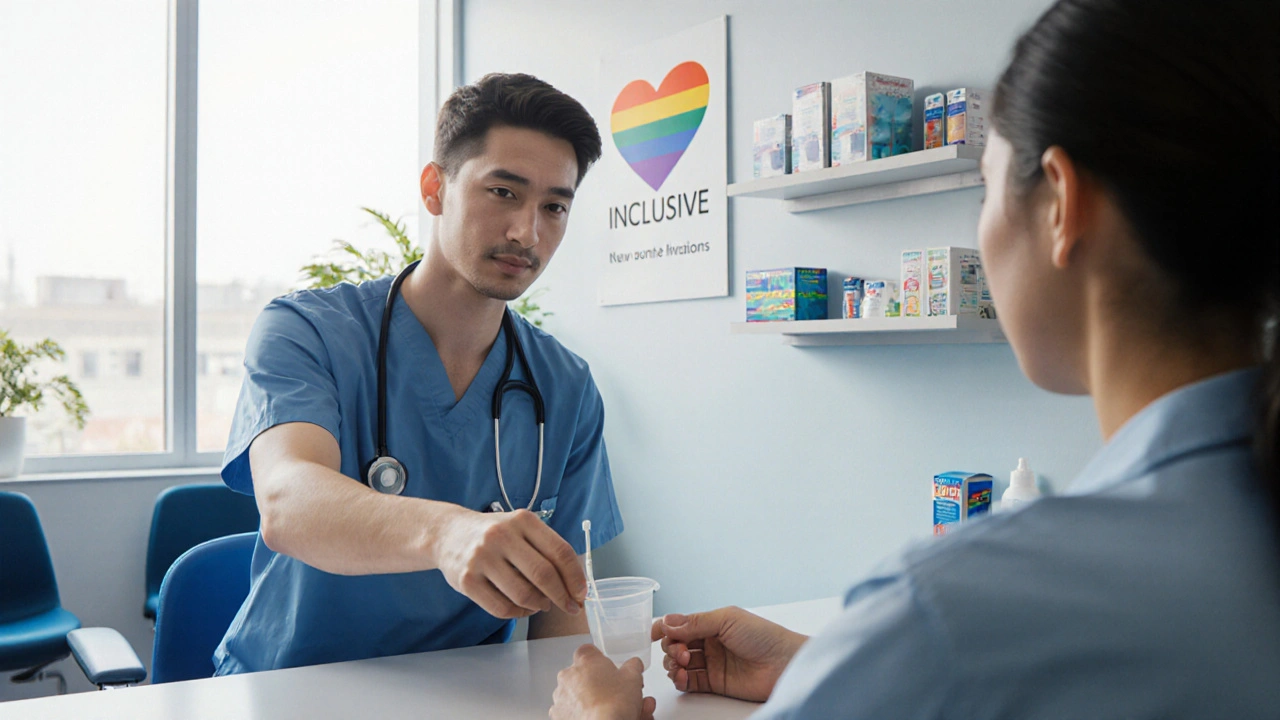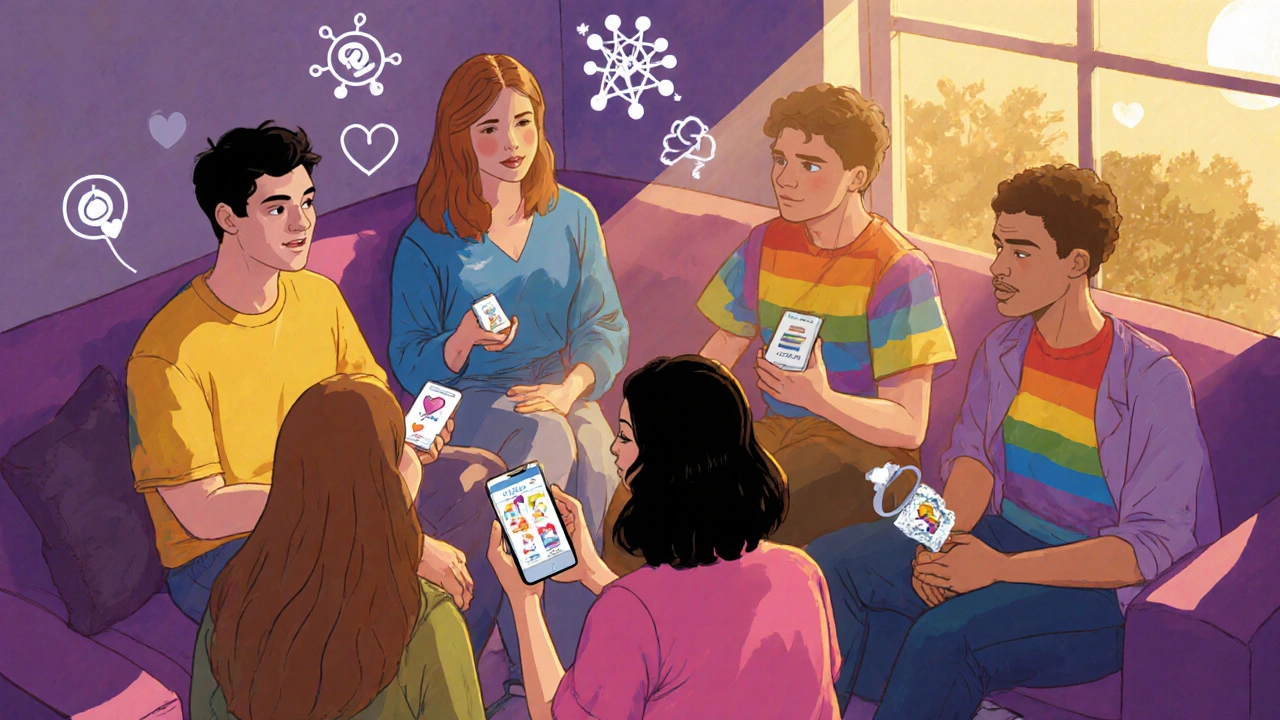Gonorrhea Risk Assessment Tool
Assess Your Risk Factors
Answer the following questions to determine your risk level for gonorrhea. This tool is specifically designed for LGBTQ+ individuals.
Your Risk Level
When it comes to sexual health, the LGBTQ+ community faces a mix of biological, social, and structural challenges that can make Gonorrhea a common bacterial STI caused by Neisseria gonorrhoeae a pressing concern. In many parts of the world, infection rates among gay, bisexual, and trans people are several times higher than in the general population, not because of any inherent risk but because of gaps in education, access to culturally competent care, and lingering stigma. This article breaks down those unique hurdles, shows how to spot the infection early, and offers practical steps to lower your risk without sacrificing intimacy.
Why rates are higher in the LGBTQ+ community
Three main forces drive the disparity:
- Network dynamics: In gay men, for example, a higher number of recent sexual partners can create a faster transmission cycle, especially when partners meet through apps that encourage quick hookups.
- Targeted prevention gaps: Public campaigns often focus on heterosexual condom use, leaving LGBTQ+ people without tailored messaging about rectal or oral exposure.
- Stigma social and internalized prejudice that discourages open discussion about sexual health - many avoid testing for fear of discrimination, allowing infections to go undetected.
Data from the WHO’s 2023 surveillance report show that gay and bisexual men accounted for nearly 50% of new gonorrhea cases in high‑income regions, while transgender women experienced infection rates up to three times the national average in several South African cities.
Common myths that fuel risk
Myth #1: "If I’m on PrEP, I’m safe from all STIs." PrEP protects against HIV, not bacterial infections. Myth #2: "Oral sex is risk‑free." Gonorrhea can colonize the throat and be passed on via kissing or oral contact. Myth #3: "I’m only at risk if I have ‘unprotected’ sex with a woman." The bacteria doesn’t care about gender; it exploits any mucous membrane it can reach.
Debunking these ideas starts with honest conversations-both with partners and with providers who understand LGBTQ+ health.

Spotting symptoms and knowing when to get tested
Symptoms vary by exposure site:
- Urethral: Burning during urination, white or yellow discharge.
- Rectal: Discharge, bleeding, soreness, or sometimes no symptoms at all.
- Pharyngeal (throat): Sore throat, but most infections are silent.
Because many infections are asymptomatic, the only reliable way to know your status is through STI testing laboratory analysis of urine, swabs, or throat samples. Guidelines recommend at least yearly testing for sexually active LGBTQ+ adults, with more frequent screening (every 3-6 months) for those with multiple partners or who engage in condom‑less sex.
Prevention strategies that actually work
Effective protection is a blend of behavioral and biomedical tools:
- Consistent condom use-both latex and polyurethane-reduces urethral and rectal transmission by up to 80%.
- Dental dams for oral‑genital contact lower throat exposure.
- Regular screening-catching an infection early prevents onward spread.
- Partner communication-disclose recent STI history and discuss testing plans.
- Consider pre‑exposure antibiotic strategies only under clinical supervision; routine prophylactic antibiotics are not recommended due to resistance concerns.
For gay men, the CDC’s 2024 "Sexual Health Toolkit" highlights a practical tip: keep a small condom kit in your pocket or bag, just like you would a phone charger.
Treatment, antibiotic resistance, and what’s changing
The standard regimen in most countries (as of 2025) is a single intramuscular dose of Ceftriaxone 500mg combined with oral Doxycycline 100mg twice daily for seven days when Chlamydia co‑infection is suspected. However, rising antibiotic resistance the ability of Neisseria gonorrhoeae to survive standard drug doses has prompted health agencies to monitor treatment failures more closely.
Below is a quick comparison of the most common first‑line options and emerging alternatives:
| Regimen | Dosage | Effectiveness | Resistance Concerns |
|---|---|---|---|
| Ceftriaxone + Doxycycline | 500mg IM single dose + 100mg PO BID×7days | ≈95% | Emerging decreased susceptibility in Asia & Africa |
| Cefixime monotherapy | 800mg PO single dose | ≈85% | High failure rates in Europe (2023‑24) |
| Azithromycin (reserve) | 2g PO single dose | ≈70% | Widespread macrolide resistance |
| Spectinomycin (alternative) | 2g IM single dose | ≈80% | Limited availability, modest resistance |
If you receive a prescription, finish the full course even if symptoms vanish. Incomplete treatment fuels resistant strains and puts your partners at risk.

Finding LGBTQ‑friendly sexual health clinics
Not all clinics feel safe for queer patients. Here’s how to locate one that does:
- Check for explicit statements about “LGBTQ+ inclusive services” on the clinic’s website.
- Look for staff credentials such as “Certified LGBTQ+ Health Provider” or “HIV/STI Specialist.”
- Ask community groups (e.g., local Pride organizations) for recommendations.
- Use national directories like the South African National AIDS Council’s “Safe Spaces” list, which tags facilities with sexual health clinic centers offering testing, treatment, and counseling services geared toward queer patients.
When you walk in, expect a non‑judgmental intake form that asks about gender identity, pronouns, and sexual practices-this information helps clinicians tailor testing panels.
Practical checklist for staying ahead of gonorrhea
- Schedule a comprehensive STI screen at least once a year, or every 3-6 months if you have multiple partners.
- Carry a small condom kit (condom, lubricant, dental dam) wherever you go.
- Talk openly with partners about recent testing dates; consider a joint testing appointment.
- If you notice any unusual discharge, burning, or sore throat, get tested within 48hours.
- Complete the full antibiotic regimen even if you feel fine.
- Inform all recent sexual partners so they can test and treat promptly (contact tracing).
- Follow up with your clinic 1‑2 weeks after treatment to confirm cure, especially for rectal or pharyngeal sites.
- Stay updated on local resistance trends-some regions have shifted to higher‑dose ceftriaxone protocols.
By treating your sexual health like any other wellness routine, you reduce personal risk and help curb the spread within the broader community.
Frequently Asked Questions
Can I get gonorrhea from oral sex?
Yes. The bacteria can colonize the throat and be transmitted through kissing or unprotected oral‑genital contact. Because throat infections often have no symptoms, regular testing is the only reliable safeguard.
Is it safe to rely on PrEP alone for STI prevention?
PrEP protects against HIV but does not prevent bacterial STIs like gonorrhea. Combine PrEP with condoms and routine testing for comprehensive protection.
How long does it take to get test results?
Most clinics can provide results within 2-5 business days for urine or swab samples. Rapid NAAT (nucleic acid amplification test) kits are now available in several urban centers and can deliver results in under an hour.
What should I do if my partner tests positive?
Encourage them to complete treatment and attend a follow‑up test. You should also get tested, even if you feel fine, and consider prophylactic treatment if advised by a clinician.
Are there any vaccine prospects for gonorrhea?
Research is ongoing. A 2023 study showed that a meningococcal vaccine offered about 30% cross‑protection, but a dedicated gonorrhea vaccine is still in clinical trials and not expected before the early 2030s.
Understanding the nuances of Gonorrhea in the LGBTQ+ community empowers you to make informed choices, protect your partners, and push back against the misconceptions that keep the infection circulating. Stay proactive, stay tested, and remember that good sexual health is a shared responsibility.

Hey everyone, let’s take a moment to acknowledge how important it is to talk openly about gonorrhea within our LGBTQ+ community. First off, the risk isn’t tied to any one identity; it’s about the behaviors we engage in and the protections we use. Using condoms consistently during anal and vaginal sex cuts the transmission risk dramatically, so keep those stocked and don’t skimp on the latex. If you’re on PrEP, remember it doesn’t protect against bacterial STIs like gonorrhea, so regular testing is still essential. Speaking of testing, aim for a full STI screen at least once every three months if you have multiple partners or engage in condom‑less sex. Many clinics now offer rapid gonorrhea tests, and some even have self‑collection kits you can use at home, which reduces barriers to getting checked. If you ever test positive, treatment is simple-usually a single dose of antibiotics, but you must finish the entire prescription and inform recent partners so they can get treated too. Partner notification can feel awkward, but it’s a crucial step to curb spread; use anonymous notification services if you’re uncomfortable reaching out directly. Remember that antibiotic resistance is on the rise, so completing treatment exactly as prescribed helps preserve medication effectiveness. For those who engage in oral sex, keep in mind that gonorrhea can infect the throat and often shows no symptoms, so regular throat swabs are a smart addition to your testing routine. Hydration and a healthy immune system won’t prevent infection, but they can support recovery if you do get sick. If you’re on hormone therapy, there’s no evidence that it changes susceptibility, but maintaining overall health benefits your sexual wellbeing. Community resources like LGBTQ+ health centers and online forums can provide non‑judgmental support and up‑to‑date information on local testing sites. Finally, don’t let stigma stop you from seeking care-your health matters, and taking proactive steps protects both you and your partners.
Thanks for the tool, super helpful and motivating!
Appreciate the thoroughness, the risk matrix is clear, concise, and well‑structured, providing actionable steps.
Great ressource! I think it helps prttend we cna talk about this stuff without feer.
Indeed, the information is solid; I would simply add that many clinics now offer walk‑in appointments without the need for a prior appointment, which can further reduce barriers.
From a cultural perspective, it’s vital to recognize that certain sub‑communities may experience heightened stigma around STIs, and tailored outreach can improve testing uptake.